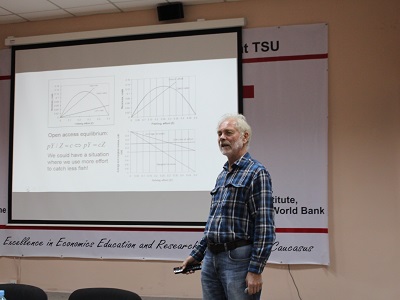On November 7, ISET hosted Professor Rögnvaldur Hannesson of the Norwegian School of Economics, who gave a presentation entitled ‘Tradable Fish Quotas and Return on Capital in Norwegian Fisheries’.
Dr. Hannesson started by defining a key problem facing the Norwegian fishing industry. Water basins are generally considered to be common property, as well as the fish inside them, and so fishermen consider water basins as an unlimited resource for their profit. However, this problem usually leads to a situation wherein fishermen use more effort to catch a fish than the revenue returns their work brings. Dr. Hannesson explained that there are two ways to solve the problem: the introduction of taxation or quotas. Dr. Hannesson used data from the Norwegian fishing industry to check whether the introduction of quotas does indeed help to solve the problem of overfishing and to increase return on capital in this industry.
Economic efficiency requires that quotas be allocated to individual firms and made transferable. It will result in a situation wherein redundant fishing boats will have to sell their quotas, leaving only the most efficient vessels to actually go fishing. In Norway, quotas are valid for 20 years with restrictions on transferability, but quotas can be transferred from boats that are scrapped.
Dr. Hannesson discussed several outcomes from his research. First, the introduction of a quota system in the fishing industry resulted in fewer boats catching the available fish; second, the price for quotas was overestimated by investors. The third and the main outcome of research is that the return on boat capital has increased handsomely, although only partly due to the quota regime. However, once asset values of purchased fish quotas are accounted for, the return on total capital in the industry has hardly changed at all. A widening gap has opened up between the return on boat capital and total capital including fish quotas, which is an indicator of the efficiency of the introduction of quotas.











